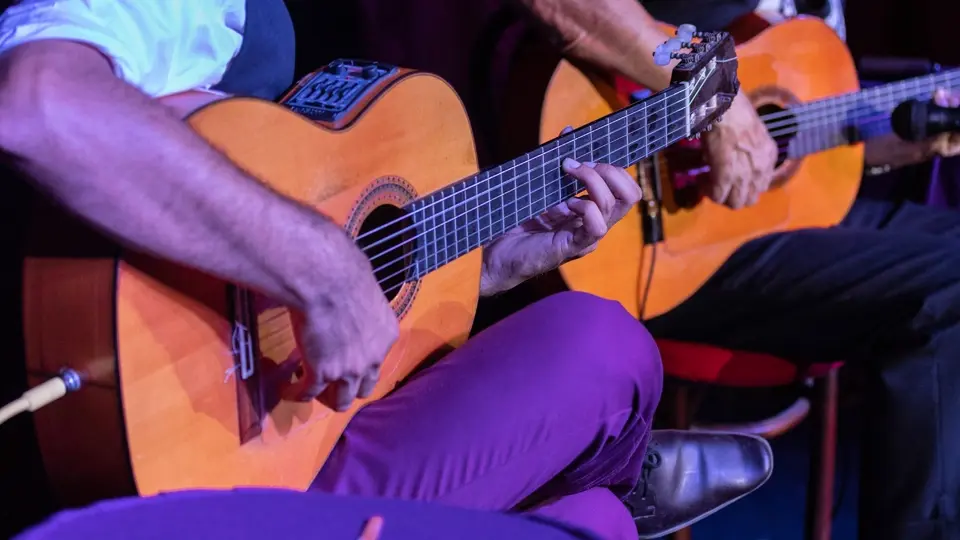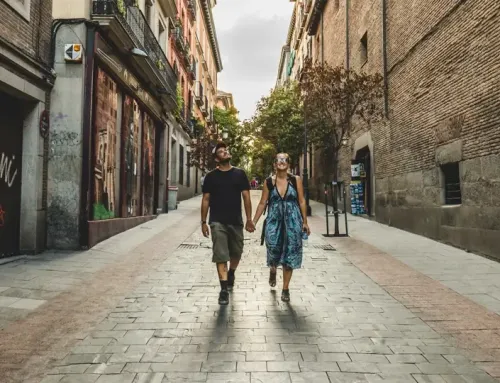The Flamenco Dress: A Living Tradition and Fashion in Motion
Every year, Andalusia dresses up for a party. Amid the lights, music, and joy, one star never goes unnoticed: the flamenco dress. It’s not just a garment; it’s a statement of identity and a work of art that’s reinvented year after year. The most fascinating aspect is that it is the only regional costume in Spain that evolves with trends, becoming pure fashion.
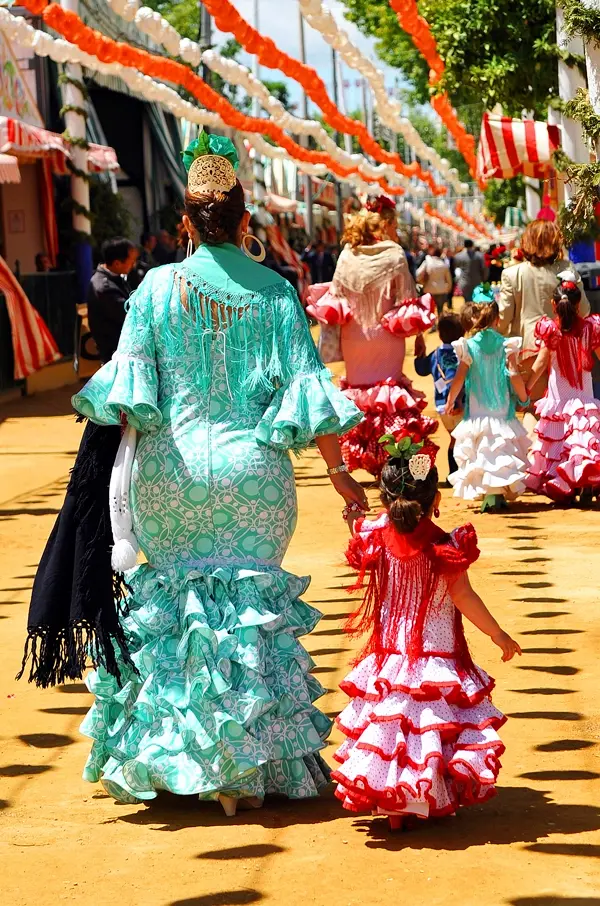
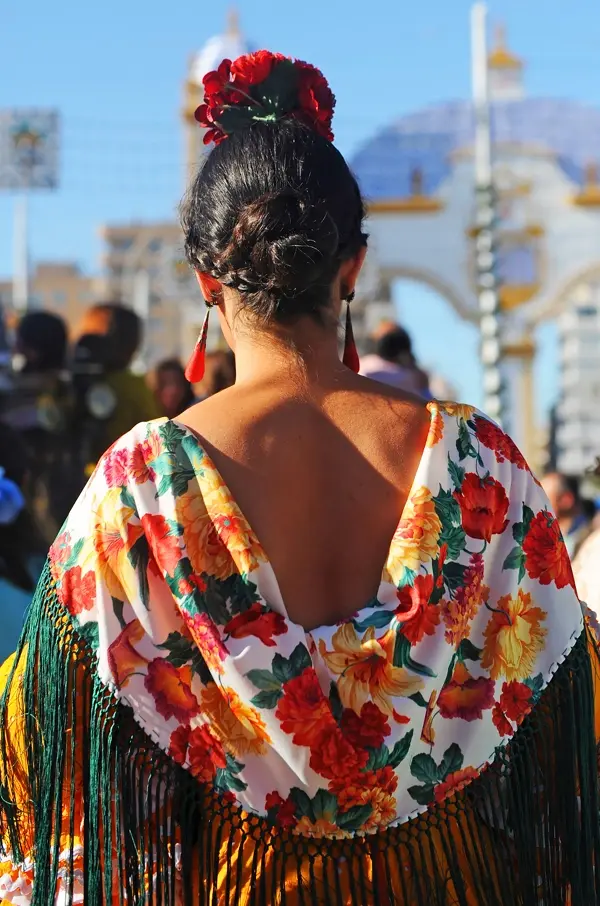
THE ORIGIN AND EVOLUTION OF THE FLAMENCO DRESS
Every year, Andalusia dresses up for a party. Amid the lights, music, and joy, one star never goes unnoticed: the flamenco dress. It’s not just a garment; it’s a statement of identity and a work of art that’s reinvented year after year. The most fascinating aspect is that it is the only regional costume in Spain that evolves with trends, becoming pure fashion.
The origin and evolution of the flamenco dress
Its origin dates back to 19th-century Andalusia, specifically to livestock and agricultural fairs. Initially, it was not designed as a dance costume but rather as the attire worn by women of humble backgrounds, particularly gypsies, to attend these popular events.
In its early days, the dress was simple, with long skirts and a few ruffles, and a shawl was draped over the shoulders. Working-class women adapted it using whatever materials they had on hand, creating a recognizable style blending gypsy and Andalusian influences.
In the late 19th century, ladies of Seville’s high society began adopting more refined versions of these dresses to wear to the fair, adding embellishments that elevated their status.
During the 20th century, the flamenco dress underwent significant changes. The 1920s and 1930s saw the emergence of more fitted silhouettes influenced by fashion trends. Ruffles multiplied, and colors became more intense, especially after the Spanish Civil War.
The 1960s marked a turning point with the professionalization of flamenco fashion designers. Artisanal workshops gave way to designers who began presenting annual collections and experimenting with new fabrics, prints, and shapes.
In the 1980s, the flamenco dress underwent an aesthetic revolution. The creation of the International Flamenco Fashion Show (SIMOF) in 1994 opened an international window on this tradition, allowing designers to innovate while respecting its essence.
Today, the flamenco dress has transcended its regional origins to become an icon of Spanish fashion. Each year, contemporary designers reinterpret this traditional garment, balancing innovation with respect for its historical roots and keeping a centuries-old tradition alive as it continues to evolve.
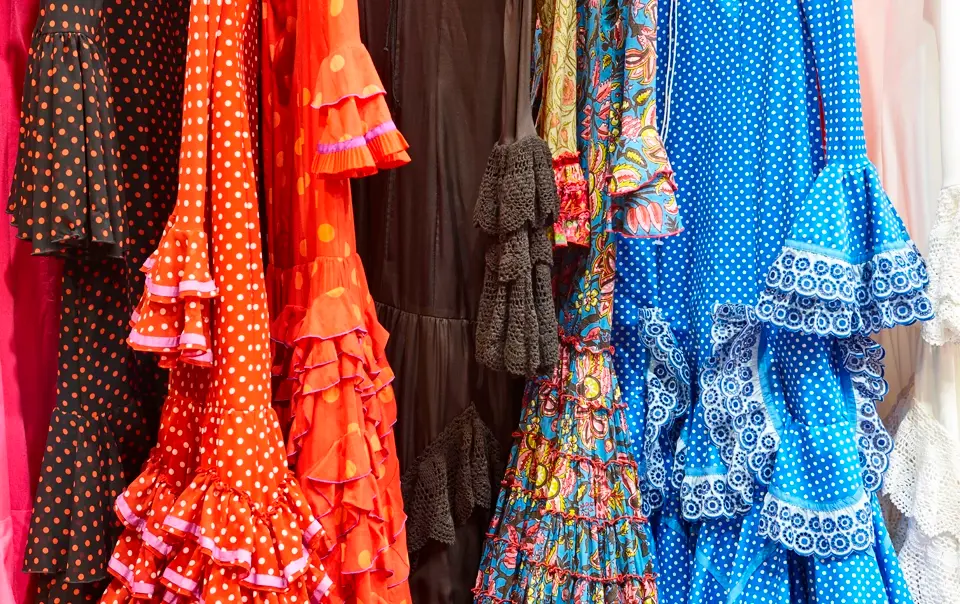
TYPES OF FLAMENCO DRESSES
One of the most fascinating characteristics of flamenco dresses is their diversity. Unlike other Spanish regional costumes, there is no single canonical model; rather, there is a wide variety that reflects different periods, geographical areas, and functions.
One of the most recognizable types is the bata de cola, a dress with a long train that can extend several meters. Initially created for professional dance, this design requires great skill to handle during performance. In contrast, the traditional flamenco dress has a straighter silhouette with numerous ruffles throughout the skirt.
For less formal occasions, there is the bata rociera, a simpler, more practical variant perfect for pilgrimages and country celebrations. It has fewer ruffles and is shorter, making it easier to move around in.
The colors and patterns of the costume speak for themselves. From classic polka dots to floral designs, each color combination can convey the wearer’s marital status, the occasion, or even their origin.
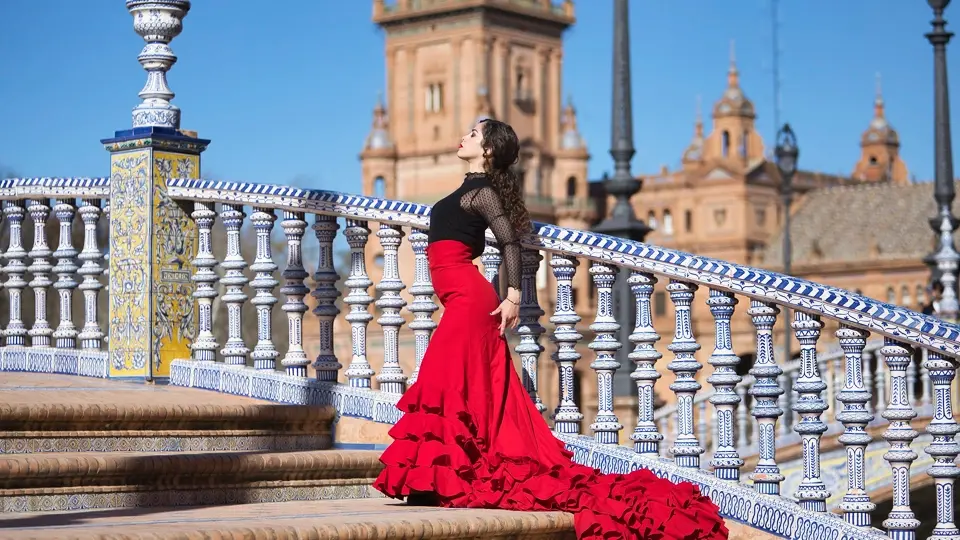
THE TRADITIONAL COSTUME IS MADE UP OF SEVERAL ELEMENTS
A traditional flamenco dress is not complete without its characteristic accessories. The mantoncillo, a smaller version of the Manila shawl, can be placed over the shoulders or tied at the waist. Flowers, typically carnations or roses, adorn the hair, which is pulled into a low bun.
Traditionally made of tortoiseshell or modern synthetic materials, combs crown the hairstyle and enhance the figure. The fan is not only a decorative element but also essential for combating the Andalusian heat during the long festive days.
The footwear deserves special mention: medium-heeled shoes with ankle straps that allow for hours of dancing without sacrificing comfort. Long, eye-catching earrings frame the face and add movement with every gesture.
Fringes, embroidery, and lace add texture and personality to each flamenco dress, making them unique.
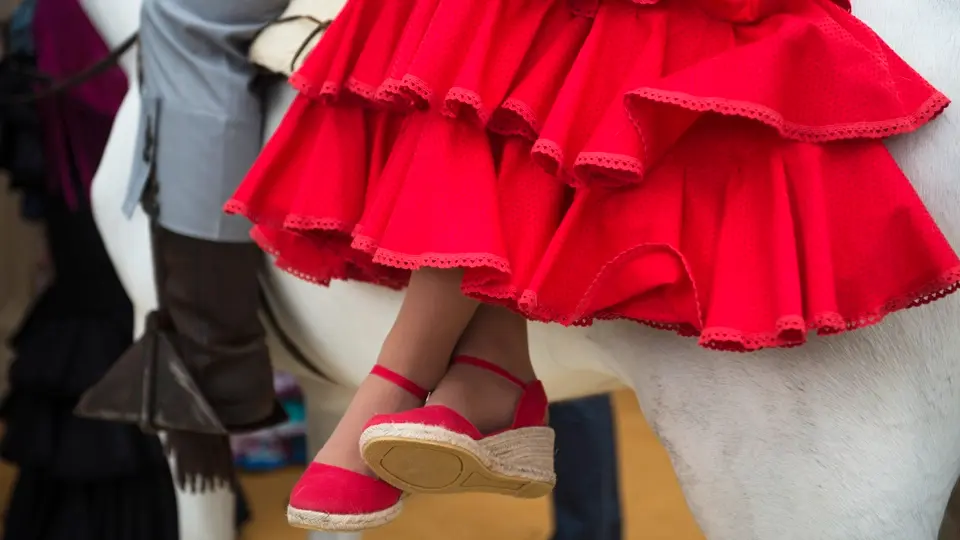
TRENDSETTING DESIGNERS
The current flamenco fashion scene is dominated by designers who have modernized this tradition without losing its essence. Designers such as Juana Martín, Pilar Vera, and Pedro Béjar have elevated the flamenco dress to haute couture status.
Martín is the first Romani woman to show at Paris Haute Couture, bringing flamenco dresses to the world’s most prestigious catwalks. In 2025, she received the National Fashion Design Award, becoming an ambassador for Andalusian culture. Her collections fuse tradition and the avant-garde with hand-embroidered details, dramatic volumes, and an emotional aesthetic.
Each season, these designers present trendsetting designs, from reviving traditional volumes to introducing innovative fabrics.
Additionally, renowned designers like Jean Paul Gaultier, John Galliano, and Dolce & Gabbana have incorporated flamenco elements into their collections.
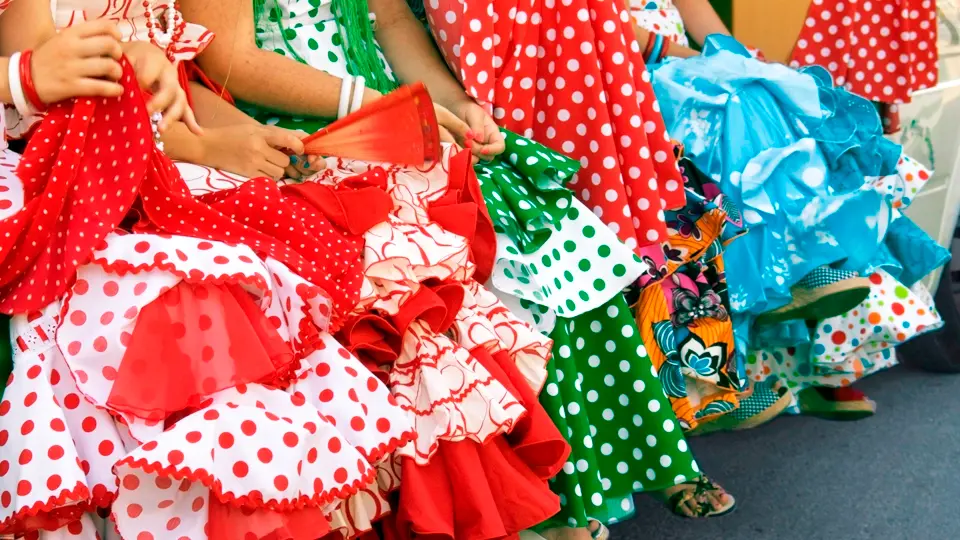
SIMOF IS AN INTERNATIONAL SHOWCASE FOR FLAMENCO FASHION
The International Flamenco Fashion Show (SIMOF) is the most important event in the sector. Held annually in Seville since 1994, SIMOF brings together more than 30 designers, who present their collections to thousands of visitors.
SIMOF functions not only as a catwalk but also as a commercial meeting point where professionals can establish contacts and close deals. It also serves as a barometer of trends for the fair and pilgrimage season.
This showcase has played a key role in the globalization of flamenco dresses, attracting buyers and specialized media from around the world. Thanks to events like this, the flamenco dress maintains its cultural relevance while evolving as a contemporary artistic expression.
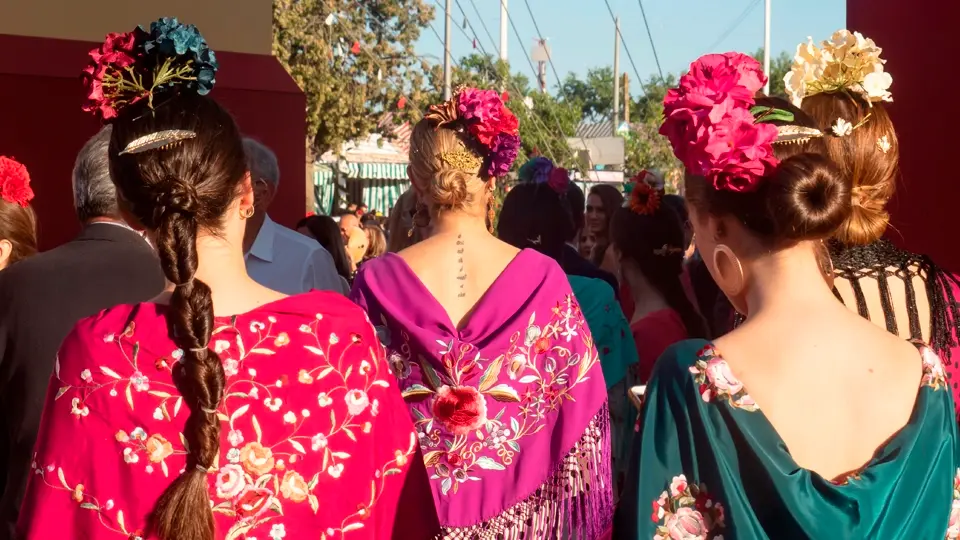
DRESS UP IN FLAMENCO STYLE AND OLÉ!
Would you like to wear a flamenco dress? Wearing this iconic garment means embracing a living tradition that transforms those who wear it.
The right dress depends as much on your personality as your figure. If you are tall, a bata de cola will flatter your figure. If you are of average height, dresses with evenly distributed ruffles will suit you better.
The color should reflect your spirit and the experience you want to have. Intense colors like red and black project strength and passion, which is perfect for a night out. Pastels and floral prints, on the other hand, convey joy and are ideal for fairground afternoons.
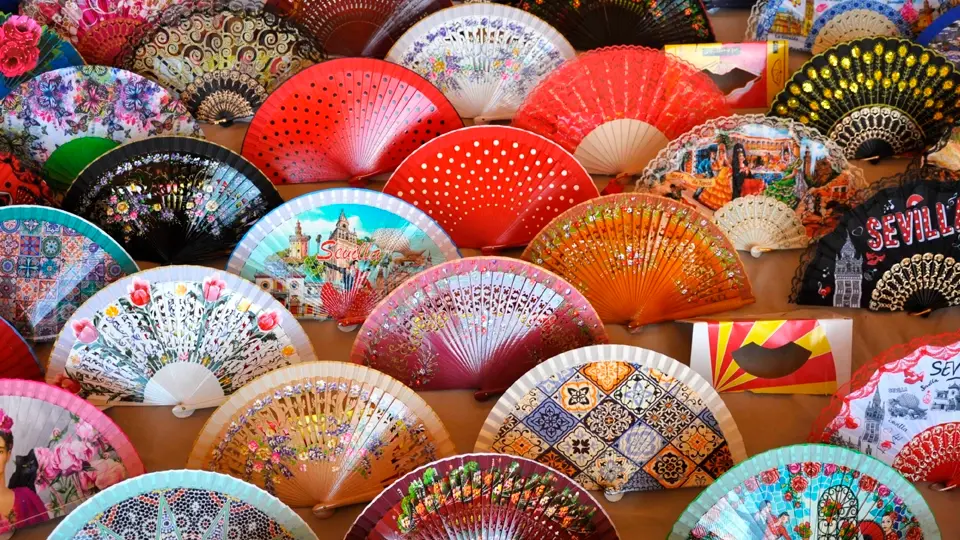
Accessories are essential for completing an outfit. The shawl should coordinate with the dress without stealing the show. Large earrings frame the face, and a flower in the hair adds an essential finishing touch.
When it comes to hairstyles, a low bun remains the most classic and flattering option. Place the comb at a slight tilt to add height to your figure without causing discomfort during hours of celebration.
Footwear deserves special attention. Choose shoes with medium heels and ankle straps that allow you to move freely. Traditional wedge espadrilles are also a good option because they are very comfortable for standing or dancing for long periods of time. Also, always carry a fan, which will keep you cool on hot Andalusian days and is an elegant accessory.
Dressing up as a flamenco dancer is a ritual that connects generations.
Finally, remember that attitude is the most important accessory. A flamenco dress is worn with pride and joy, and its ruffles come to life with every step. Olé!
